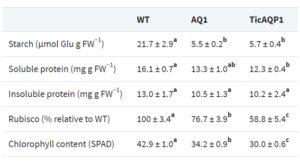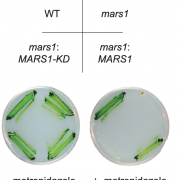Physiological performance of transplastomic tobacco plants overexpressing aquaporin AQP1 in chloroplast membranes (JXB)
 A major factor in determining photosynthetic rate is the availability of CO2 at the site of fixation in the chloroplast stroma. Classically, this has been thought to be mainly limited by stomatal conductance (diffusion from the air, through stomata, to sub-stomatal cavities). However, more recently it has been demonstrated that mesophyll conductance (gm, diffusion from sub-stomatal cavities to the stroma) also influences stromal CO2 concentrations. A major site of resistance to leaf CO2 diffusion is at the protein-rich chloroplast envelope. As such, efforts have been made to make the chloroplast envelope more permeable to CO2, through the nuclear expression of aquaporins targeted to this double membrane. Aquaporins are pore-forming proteins that enhance membrane permeability of membranes to small neutral molecules, and these studies have already shown that photosynthetic performance can be boosted using this approach. In the current study, Fernández-San Millán et al transformed the chloroplast genome of tobacco to achieve high levels of aquaporin protein accumulation in the chloroplast envelope. Surprisingly, photosynthetic performance of the transgenic lines was compromised and growth retarded, potentially due to a reduction in gm. In addition, some aquaporin protein localised to thylakoid membranes, and the authors provide evidence that thylakoid membrane integrity was diminished. This study highlights the challenges involved in engineering improvements in gm. (Summary by Mike Page) JXB 10.1093/jxb/ery148
A major factor in determining photosynthetic rate is the availability of CO2 at the site of fixation in the chloroplast stroma. Classically, this has been thought to be mainly limited by stomatal conductance (diffusion from the air, through stomata, to sub-stomatal cavities). However, more recently it has been demonstrated that mesophyll conductance (gm, diffusion from sub-stomatal cavities to the stroma) also influences stromal CO2 concentrations. A major site of resistance to leaf CO2 diffusion is at the protein-rich chloroplast envelope. As such, efforts have been made to make the chloroplast envelope more permeable to CO2, through the nuclear expression of aquaporins targeted to this double membrane. Aquaporins are pore-forming proteins that enhance membrane permeability of membranes to small neutral molecules, and these studies have already shown that photosynthetic performance can be boosted using this approach. In the current study, Fernández-San Millán et al transformed the chloroplast genome of tobacco to achieve high levels of aquaporin protein accumulation in the chloroplast envelope. Surprisingly, photosynthetic performance of the transgenic lines was compromised and growth retarded, potentially due to a reduction in gm. In addition, some aquaporin protein localised to thylakoid membranes, and the authors provide evidence that thylakoid membrane integrity was diminished. This study highlights the challenges involved in engineering improvements in gm. (Summary by Mike Page) JXB 10.1093/jxb/ery148









